Text
Reference list
Barker, Chris 2012, ‘Issues of subjectivity and identity’, in Cultural studies: theory and practice, 4th ed. SAGE, London, pp. 22 [Accessed 15 March 2017].
"Barbara Kruger Biography, Art, And Analysis Of Works". The Art Story. 2017. Web. Available at: http://www.theartstory.org/artist-kruger-barbara.htm [Accessed 22 March 2017]
Brooks, P 2001, ‘Troubling confessions: speaking guilt in law and literature’, The University of Chicago Press, pp. 9 [Accessed 15 March 2017].
Edvardmunch.org. (2017). The Scream, 1893 by Edvard Munch. [online] Available at: http://www.edvardmunch.org/the-scream.jsp [Accessed 22 March 2017].
Fridakahlo.org. (2017). Frida Kahlo's Paintings. [online] Available at: http://www.fridakahlo.org/frida-kahlo-paintings.jsp [Accessed 22 March 2017].
Gallery, S. and Gallery, S. (2017). Yasumasa Morimura - Artist's Profile - The Saatchi Gallery. [online] Saatchigallery.com. Available at: http://www.saatchigallery.com/artists/yasumasa_morimura.htm [Accessed 22 March 2017].
Gelman, Susan A. 2003, ‘The Essential Child: Origins Of Essentialism In Everyday Thought’. 1st ed. Oxford, England, U.K.: Oxford University Press,
Gopnik, A. and Rosati, A. (2001). Duck or rabbit? Reversing ambiguous figures and understanding ambiguous representations. Developmental Science, 4(2), pp.175-183.
Hall, Stuart. ‘Understanding Modern Societies’. 1st ed. Cambridge, Mass: Blackwell, 1995. [Accessed 15 March 2017]
Mansfield, N 2000, ‘Freud and the split subject’, in Subjectivity: theories of the self from Freud to Haraway, New York University Press, New York, pp. 26-35 [Accessed 22 March 2017]
Mikekelleyfoundation.org. (2017). Mike Kelley Foundation for the Arts. [online] Available at: http://www.mikekelleyfoundation.org/#!/ [Accessed 23 March 2017].
Moma.org. (2017). MoMA | Andy Warhol. Campbell's Soup Cans. 1962. [online] Available at: https://www.moma.org/learn/moma_learning/andy-warhol-campbells-soup-cans-1962 [Accessed 23 March 2017].
PsyBlog. (2017). Duck/Rabbit Illusion Provides a Simple Test of Creativity - PsyBlog. [online] Available at: http://www.spring.org.uk/2012/01/duckrabbit-illusion-provides-a-simple-test-of-creativity.php [Accessed 14 March 2017].
sengl, d. (2017). And Cut. [online] Deborah Sengl. Available at: http://www.deborahsengl.com/and_cut/ [Accessed 22 March 2017].
"The Face: Del Kathryn Barton". Theaustralian.com.au, 2017. Web.
Available at: http://www.theaustralian.com.au/arts/the-face-del-kathryn-barton/news-story/7ca31ffa5c97288d4fd8ddc4dbf71637 [Accessed 22 March 2017]
Zeccola, C. (2017). Skywhale prompts an emotional reaction to difficult things: Patricia Piccinini - Watch - ABC Arts | Australian contemporary art and culture reviews, news & videos. [online] Abc.net.au. Available at: http://www.abc.net.au/arts/stories/s3762859.htm [Accessed 22 March 2017].
0 notes
Photo
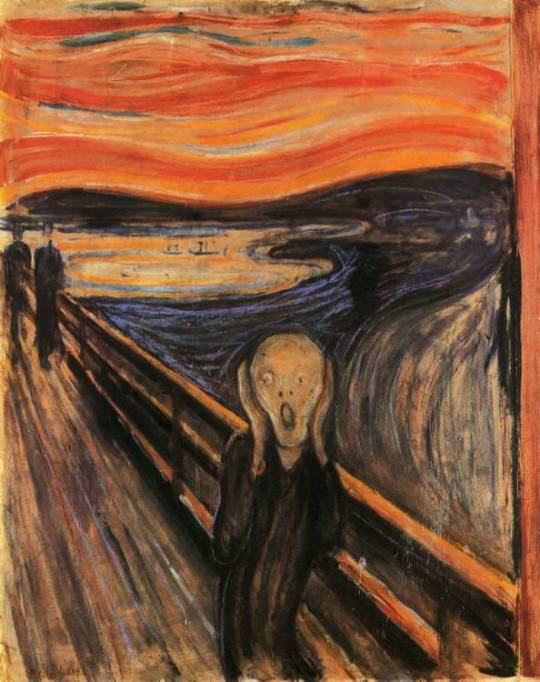
‘The Scream’ Edvard Munch (1893) - http//www.edvardmunch.org/the-scream.jsp
CREATIVE IDENTITY
Creative identity focuses on the sense of self that a creative practitioner portrays within their work. This is determined through past experiences and influences from their interior and exterior worlds.
Edvard Munch is famously known for his work above ‘The Scream’. This painting is a perfect example of an artists identity being projected through their creative work. Munch suffered from depression and hallucinations as well as multiple other mental illnesses. ‘The Scream’ is an emotionally charged work that represents some of his dark times and based off one of his hallucinations. In the two quotes below you can see that the artist values his mental illness’s and dark sense of self as a tool for his art.
"My fear of life is necessary to me, as is my illness. Without anxiety and illness, I am a ship without a rudder ... my sufferings are part of my self and my art. They are indistinguishable from me, and their destruction would destroy my art."
"Illness, insanity and death were the black angels that kept watch over my cradle and accompanied me all my life.”
(Both quotes taken from Edvard Munch’s diary around the time ‘The Scream’ was painted).
0 notes
Photo

'And Cut!' Deborah Sengl (2012) - http//www.deborahsengl.com/and_cut/
FRACTURED IDENTITY
Fractured identity is the idea that our sense of self is divided or ‘fractured’, straying in various directions leaving our identity muddled with contradictions (Hall 1996).
As visual arts is my preferred creative practice and i struggle to follow a theme as my style is constantly changing. According to Hall in 1996 this would be due to several, contrasting or unresolved, identities.
The title of this work above “And Cut!” by Deborah Sengl refers to an expression used on a film set. It alludes to the diverse roles we play throughout our lifetime. The headless human body is shown about to attach one of the two heads provided in the sculpture. This composition is a notion towards the idea that within us are contradictory identities and that we assume contrasting identities at different times.
0 notes
Photo
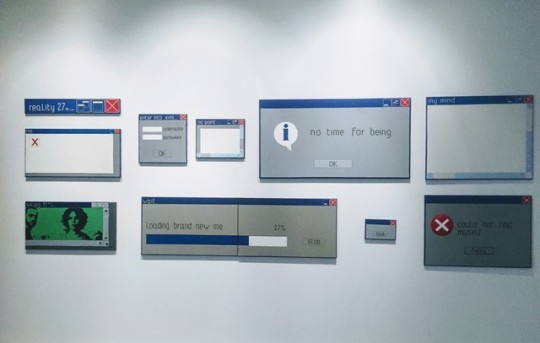
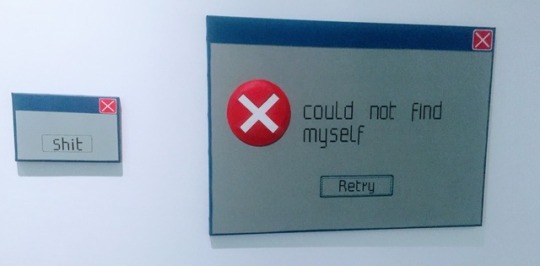
Computer window series - Laura Pawela (2004-2008) - Photos taken by myself
AUTHENTICITY
Authenticity is about being an open book of personal truth of the self and to the self (Brooks 2001, P.9). Idiosyncratic originality is sourced from beneath the surface (Haynes in 2007), and thats what makes Authenticity so important for artists when aiming to produce unique work.
This is a photo that i took of Laura Pawela’s work last year in the MOCAK (Museum Of Contemporary Art Krakow). The text “My mind” on a blank computer screen especially reached out to me as i was travelling in Poland when coming across this piece and felt that despite being in a place full of inspiration my mind was still blank.
Pawela unveils her honest self throughout these works. She is breaking away from 'the self’ society wants/expect to see and presents the all of the raw truths about how she truly feels about her self.
0 notes
Photo
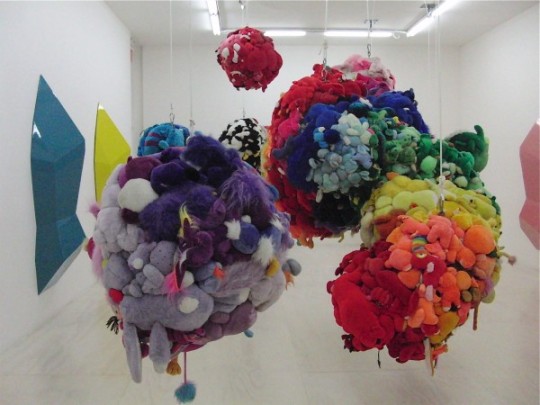

‘Deodorized Central Mass with Satellites’ Mike Kelley (1991/1999) - http://momaps1.org/exhibitions/view/374
‘Campbells Soup’ Andy Warhol - https://au.pinterest.com/explore/andy-warhol-soup-cans/
CREATIVE INFLUENCE
Creative influence is using preexisting works from artists and cultural factors to fabricate new creative direction. This is unavoidable in creative practice as we are constantly being exposed to new information that assists us with building our own creative ideas.
Mike Kelley was creatively influenced by the Iconic artist Andy Warhol. He was inspired by Warhols use of common, household objects. You can see in his work above ‘Deodorized Central Mass with Satellites’ (1991/1999) that he has made extraordinary sculptures from such basic, otherwise boring items. A renowned example of this is Andy Bulls Campbell soup series. Kelley fits into the pop art genre. a movement in which Andy Warhol was an essential contributor.
0 notes
Photo

'Rabbit or Duck’ [unknown artist] Psychologist who studied this work - Joseph Jastrow (1899) - http://www.today.com/pets/rabbit-or-duck-124-year-old-drawing-has-both-if-t73606
SENSORY KNOWLEDGE
Sensory Knowledge is the detailed understanding of the world around us in which we are able to gain direct access through our senses (hearing, sight, smell, touch and taste). When these senses send stimulations to our brain we use the knowledge that we already have of the world to order and categorise the information we are sensing.
When practicing in visual arts my sense of sight is the highest in demand for receiving relevant information on artworks.
The ambiguous sketch above is an optical illusion that sparks the idea of perception as not only being what one sees but also a mental activity. Joseph Jastrow conducted a study to see how quickly participants could change their perception of the drawing and switch between visualising each animal individually. (Jastrow 1899, p. 312)
0 notes
Photo

‘Sky Whale’ Patricia Piccinini (2013) - http//3.bp.blogspot.com/-q1Yx5rX2SEg/UZIKuDUxk_I/AAAAAAAAIMM/DngveExdXt0/s1600/image2.jpeg
OVERDETERMINATION
According to Mansfield (2000, p.29) every reaction we make even the most mundane behaviours have acute psychological complexity. In visual arts, viewers and critics are constantly looking for an explanation behind every feature in an artwork. This refers back to Mansfield’s idea that nothing can be a coincidence.
When Patricia Piccinini’s ‘Sky Whale’ first took flight across Canberra’s skies in 2013 it seemed as if every man and their dog had a comment or question about this ambiguous cluster of floating mammaries. ‘Sky Whale’ could not just be. The public demanded an explanation of how a whale-bird hybrid with ten breasts as wings could possibly relate back to the centenary of our nations capital. Alas, Mansfields theory was exemplified when piccinini released an article revealing Sky Whale and all of its perks to have complete relevance to Canberra composition.
0 notes
Photo




close up of ‘Come of things’ Kathryn Del Barton 2010 -https://www.artgallery.nsw.gov.au/collection/works/74.2010.a-b/
‘for the feeling’ Kathryn Del Barton (2011) - https://au.pinterest.com/ecrow7/art-inspire/
My own drawings representing how the unconscious mind delves deep inside the 'self' yet it lays there uncontrolled as its unreachable
My own drawing representing the unconscious mind being active flowing through our body and actions.
UNCONSCIOUS
Freud (1915) claims that our unconscious influences feelings, judgements and behaviour. This unconscious part of our mind withholds our deepest and darkest desires some which have been embedded in us since birth. These are inaccessible for us to bring to consciousness and overruled by our ego and super ego allowing us to make appropriate actions and responses.
According to Freud (1915) one of the three ways to access the unconscious mind is dreams. Kathryn Del Barton captures the depth of the unconscious mind throughout her watercolour portraits. Her works often portray an explosion of unusual patterns that have an unrealistic dream-like aesthetic. When you look past Bartons use of bright colours her works are rather dark and unveil the raw human self. The snake and the leopard in the compositions above are both animals that traditionally represents evil and power. This exemplifies Freud’s idea of darkness brewing in the unconscious.
0 notes
Photo
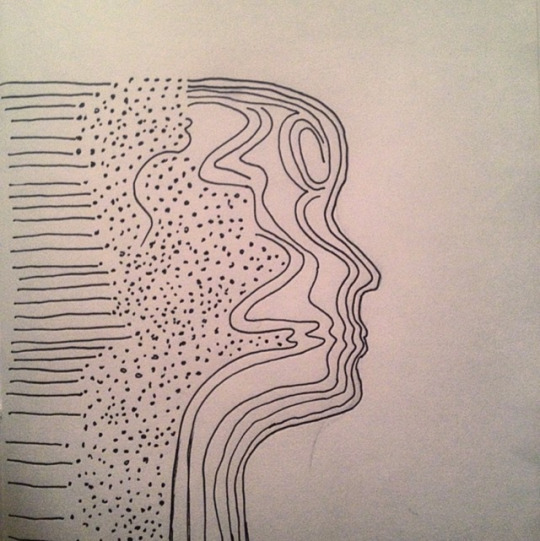

‘Mind Galaxy’ A drawing i did myself capturing the layers of essentialism running through 'the self'
‘untitled’ Barbara Kruger (1997) - https://au.pinterest.com/pin/115475177918263973/
ESSENTIALISM
Essentialism is the immutable core of oneself. Gelman (2003) theorises that identity is an essence that captures true nature and reality beneath the categories society pins us in.
This theory claims that there are set foundational characteristics in each societal group. For females that means they can be defined by their gender. In the past (and still in some countries today) being a woman came with the label of being ‘beautifully stupid.’ Barbara Krugers work above rejects this idea and is an example of an anti-essentialism. She forms a meaning completely the contrary to the statements on her artwork as she justifies by stating “not ironic enough” on one edge.
0 notes
Photo



‘Self portrait’ Frida Kahlo (1940) - http://www.artyfactory.com/art_appreciation/portraits/frida_kahlo.htm
‘The two Fridas’ Frida Kahlo (1939) - http://www.fridakahlo.org/the-two-fridas.jsp
SUBJECTIVITY
Subjectivity is the processes in which we become a person. Biological and cultural forces identify us as subjects and control how we experience ourselves. (Barker 2008)
In Frida Kahlo’s self-portraits above her psychological response to adversity is revealed. As a visual arts creative practitioner i feel as if Kahlo shows a transparent understanding of her self throughout these artworks. Although her self-portraits are almost gory in a way they covey her response to the series of unfortunate events throughout her lifetime and her loss of ambition as a result. These factors shaped Kahlo’s identity and therefore her work. Kahlo illustrates the existentialism of being an individual throughout her creative practice.
0 notes